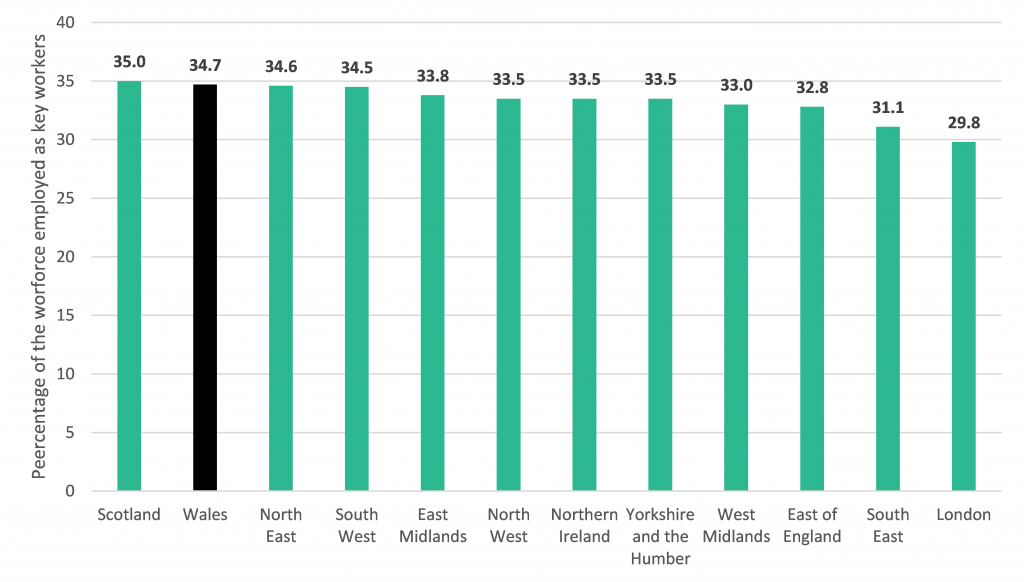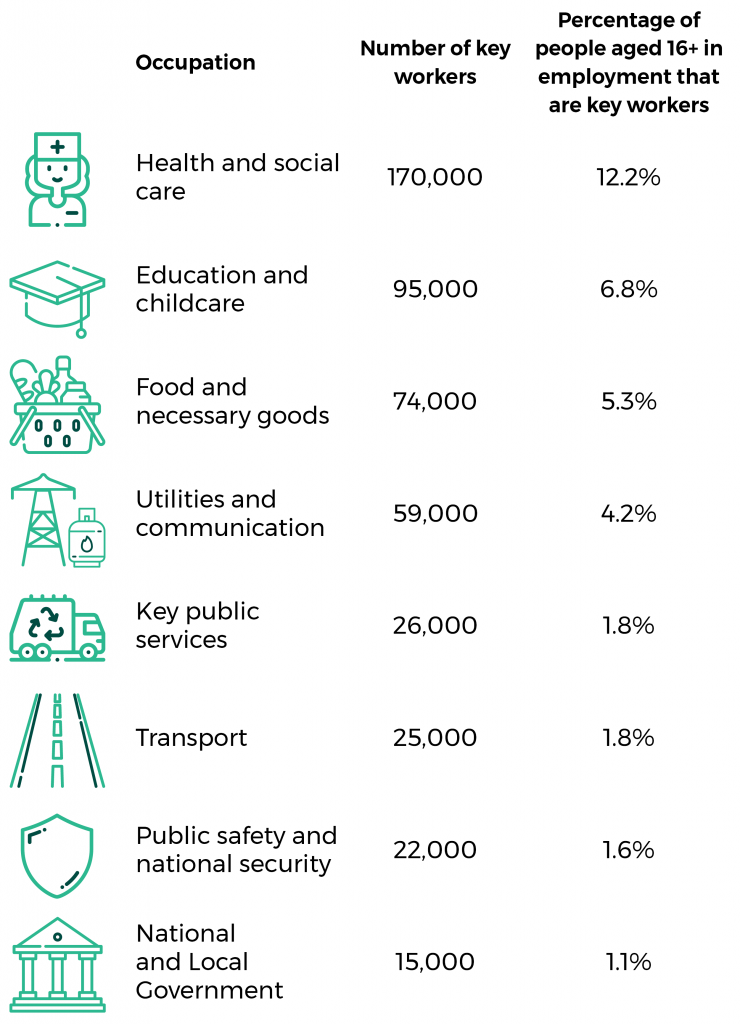Every Thursday evening people across Wales clap for the key workers who make up 35% of our workforce. This is higher than the UK average, and higher than all English regions and Northern Ireland.
This article sets out data on key workers in Wales, including what occupations they work in, the characteristics of key workers, and the extent to which key worker occupations are potentially exposed to coronavirus.
In the light of recent political and media commentary on this topic, we’ve also published an article on key worker pay and working conditions today.
Our articles on personal protective equipment (PPE) and testing cover these topics in respect of key workers.
There are nearly half a million key workers working in different sectors in Wales
The Welsh Government has said that there are 483,000 key workers in Wales.
The Office for National Statistics (ONS) published data on coronavirus and key workers in the UK, which gives a slightly higher figure of 485,000 key workers. It uses the Annual Population Survey to calculate figures for key workers across the UK in 2019. The maps and graphs in this article use this data, as it allows for comparisons to be made across the UK, and to look at where key workers are in Wales, the sectors they work in, and their characteristics.
Percentage of the workforce employed as key workers in 2019
 Source: Office for National Statistics, Coronavirus and key workers in the UK
Source: Office for National Statistics, Coronavirus and key workers in the UKKey workers undertake a number of critical roles across the private, public and third sectors to respond to the coronavirus pandemic. Over a third of key workers in Wales work in health and social care, and one in five work in education and childcare.
Number of key workers in Wales employed in each sector
 Source: Office for National Statistics, Coronavirus and key workers in the UK
Source: Office for National Statistics, Coronavirus and key workers in the UKWorkers in the ‘health and social care’ and ‘food and necessary goods’ sectors make up a greater percentage of the Welsh workforce than the average across the UK. Utilities and communications workers represent a lower share of the Welsh workforce than that of the UK.
Key workers make up a bigger proportion of the workforce in some areas
Across Wales, key workers in rural and Valleys local authorities tend to make up a greater percentage of the workforce, with over 40% of the workforce in Anglesey, Blaenau Gwent and Ceredigion employed as key workers.
Percentage of the workforce in each local authority employed as key workers

Women and people from BAME groups are more likely to be key workers
There are more female key workers across the UK than men. The ONS has found that 58% of key workers are women. In the education and childcare sector, 81% of workers are female, and 79% of health and social care workers are female. In contrast, 90% of transport workers, and over 75% of utilities and communication workers, are male.
The ONS also found that across the UK 14% of key workers are from black, Asian and minority ethnic (BAME) backgrounds, compared to 12% of all workers. BAME workers are particularly likely to work in two sectors – 19% of health and social care workers are from BAME groups, as are 15% of utilities and communications workers.
Some key worker jobs are more exposed to the virus
Across the UK, the ONS has found that some key worker occupations are exposed to coronavirus on a daily basis. Unsurprisingly, this includes many healthcare occupations such as dentists, doctors, nurses, ambulance staff, dental nurses and nursing assistants.
Three in four workers in occupations with the highest exposure to coronavirus are women. These include occupations such as midwives, nurses, dental nurses and veterinary nurses.
One in five workers in occupations with the highest exposure to coronavirus are from BAME groups, considerably higher than the percentage of the overall workforce from BAME groups. These include occupations such as dentists, medical practitioners and opticians. The Welsh Government has established a BAME COVID-19 advisory group to understand the specific impacts of coronavirus on BAME communities.
There are higher mortality rates for people working in certain key worker roles
The ONS has also published data on coronavirus-related deaths by occupation in England and Wales. This explored the 2,494 coronavirus-related deaths in the working age population up to 20 April.
Nearly two-thirds of these deaths were among men, with the rate of coronavirus-related deaths being 9.9 deaths per 100,000 men, compared to 5.2 deaths per 100,000 women.
For both men and women, the highest rates of coronavirus-related deaths could be seen in two types of occupation – caring, leisure and other services; and elementary ‘low-skilled’ occupations.
The ONS found that “men and women working in social care, a group including care workers and home carers, both had significantly raised rates of death involving COVID-19, with rates of 23.4 deaths per 100,000 males (45 deaths) and 9.6 deaths per 100,000 females (86 deaths)”.
However, the ONS also concluded that “healthcare workers, including those with jobs such as doctors and nurses, were not found to have higher rates of death involving COVID-19 when compared with the rate among those whose death involved COVID-19 of the same age and sex in the general population”.
The highest death rates of working-age people have been seen for men working in elementary occupations. These include occupations such as security guards, process plant occupations and elementary construction.
The ONS points out that the analysis ‘does not prove conclusively that the observed rates of death involving COVID-19 are necessarily caused by differences in occupational exposure’; the ONS ‘adjusted for age, but not for other factors such as ethnic group and place of residence’.
Some key worker occupations that have the highest exposure to coronavirus, and/or the highest death rates resulting from coronavirus, are also amongst the lowest paid occupations. This is one of the areas we explore in our second article on key workers, looking at pay and working conditions.
Article by Gareth Thomas and Joe Wilkes, Senedd Research, Welsh Parliament
We’ve published a range of material on the coronavirus pandemic, including a post setting out the help and guidance available for people in Wales and a timeline of Welsh and UK governments’ response.
You can see all our coronavirus-related publications by clicking here. All are updated regularly.






